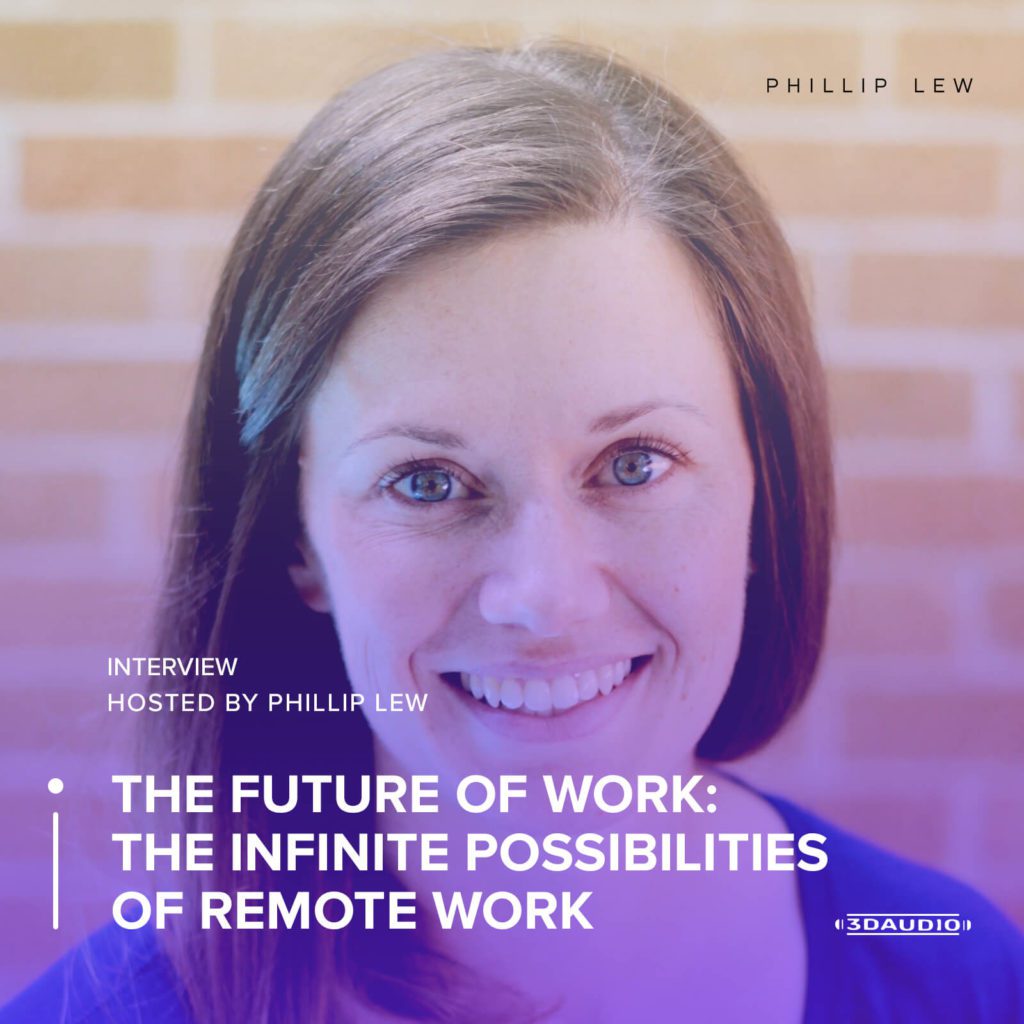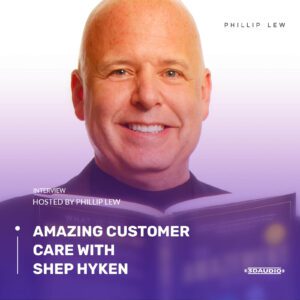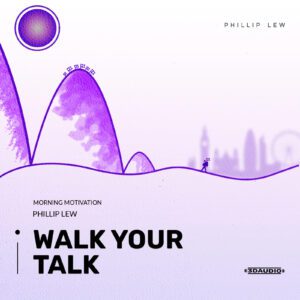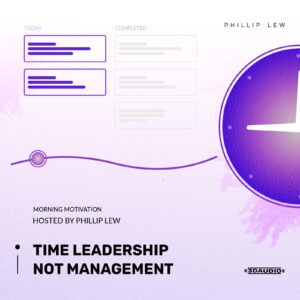
00:00
Paused.
Book Phillip to speak at your next event!
The Future of Work: The Infinite Possibilities of Remote Work
PHILLIP
Employers have the opportunity to reduce their payroll and office overhead, recruit from a more diversified talent pool, benefit from more productive and happier employees, ensure the continuity of their operations and more. Working from home is on the rise. As I write this episode of Innovators in June of 2020, the world is in the midst of a global health pandemic, only hastening the need to apply our best thinking behind the question of whether remote work really is the future of work, and if it’s ultimately the right solution for you.
To explore this fascinating subject, I decided to invite Brie Reynolds to the show. Brie leads a team of outstanding career coaches who help professionals find flexible remote career opportunities at FlexJobs. FlexJobs is the leading job search site, especially in offering the best remote, part-time, freelance and flexible jobs available.
As a coach, speaker, educator, and content creator, I knew she would be perfect in aiding our exploration into the intricacies of remote work, and help us determine what it is, its benefits, its risks, and ultimately, its destiny. So, to begin our exciting adventure, let’s listen in as Brie first shares with us her background, and what exactly she does at Flex work.
BRIE
And so, I’ve been working remotely since about 2010 and absolutely love it. Can’t imagine going back to an office every day. And what I really enjoy is helping employers and job seekers make that connection, so coaching job seekers to be excellent applicants, and teaching them what employers really look for in remote workers and what skills are going to make them particularly hirable, but also successful once they are working remotely. So that’s some of the work that I do.
PHILLIP
BRIE
And then it actually impacts the health of workers, so remote workers can make healthier choices throughout the day because they just have more control over their environments. And a lot of times when we do surveys, we see that remote workers are working in things like exercise and healthy eating into this new lifestyle that they’re creating by working from home. So from the employers’ perspective, there are so many good things about remote work, and that’s just the impact on the workforce.
I mean, when you look at remote work’s impact on their overall bottom line, it reduces operating costs, you don’t necessarily have to have large offices, you don’t have all that overhead that goes with managing an office setting. So there’s a big impact there, of course, and then there’s the environmental impact. Remote workers allow employers to reduce their environmental footprint, and just be better stewards of the environment wherever they are.
So, there’s so many benefits and it’s not to say there aren’t downsides and, you know, pros and cons to working remotely, which I’m sure we can talk about. But overall, there are really a lot of good benefits that for both the employees and the employers make sense to adopt remote work.
PHILLIP
But what exactly is remote work? What are the different variations deployed by leading organizations today? And which variation makes sense for your business or lifestyle? I decided to ask Brie to give us a simple definition of remote work to help us as both employers and employees better understand our options as we explore this exciting topic.
BRIE
So there are the 100% remote types of jobs where you are working from home all the time and you don’t set foot into the office. And from our data, the job listings that we see, that’s about 30% of the remote jobs out there are remote only jobs, where you are at home all the time, you don’t set foot in the office. And then the biggest group that we see are hybrid remote jobs, where you are working from home sometimes and you’re working either in an office or meeting with clients face to face. You’re doing some sort of in-person interaction as part of your job. And that’s about 40% of the listings that we see are that hybrid type of remote work.
And then there is the other kind, which is remote work optional, which essentially means that an employer says, “Yes, we do offer remote work, but there isn’t a standard schedule or set practice for the company as a whole. It’s really individualized to each particular role.” So someone might be able to work from home one day a week, and other people work from home 50% of the time. So the option for remote work that’s about the other 30% of the remote jobs that we see.
So it really depends on the employer and how they want remote work to integrate with their overall workforce, but also, you know, as a worker, they — people have control over what types of remote work they’re going after. So when you’re searching for remote jobs, that’s really important to know is like, how much do you actually want to work from home because that can impact the types of work that you go after or the specific, you know, the amount of options you might have.
So those are some of the main ways that we talk about remote work, but also, you mentioned at the beginning, co-working spaces and things like that. And that is a big part of remote work, too. I think the rise of co-working spaces has coincided with the rise of remote work and the rise of freelancing for a reason because even if you’re working remotely 100% of the time, you may want some in-person interaction with other human beings. That’s kind of a natural thing to require for yourself. So, co-working spaces are growing to fit that kind of a need, where you don’t necessarily want to go all the way to the office, but maybe you could find a local place to go and interact with other professionals and just get that human connection that we all crave a little bit.
PHILLIP
BRIE
PHILLIP
BRIE
So, some things that people should consider when they’re both applying for and starting to work remotely, the biggest skill that we find makes a successful remote worker is communication. And that’s verbal communication and communication in writing. Employers — when we do surveys of employers, every single time, almost without exception, the employers will say the number one skill that they’re looking for in remote workers is communication. And it’s across the board, doesn’t matter what your actual job is, like you were saying, the functions of your job. It is communication. You need to be able to communicate because when you’re not in person, you lack body language, you lack other visual cues, and you need that written and verbal communication to be a stand in for the stuff that we don’t get when we’re not face to face.
And even video, you know, you can do all sorts of video meetings and things like that, but it’s still there’s that piece of it missing when you’re not in person face to face. And so, communication is key. And that includes things like, you know, phone calls and emails and just being clear and concise in your writing, being clear about what you need from other people, but also, not being afraid to speak up for yourself and ask questions when you are in need of information or you aren’t sure which way to go with a particular issue. You know, being open to starting conversations like that is a really key piece of it because that’s–
PHILLIP
BRIE
Some other skills that really come in handy with remote work are things like time and task management, really being able to–
PHILLIP
BRIE
And then really figuring out ways to get your people fix and understand how you operate best. So for me, I like to work from coffee shops or libraries or things like that every once in a while just to get out around other people. Some people like to do that every single day. So really evaluating yourself and figuring out, “What level of interaction do I prefer? How do I work best?” You know, “How much alone work do I need versus working around other people?” And that will give you a sense of the type of remote work arrangement that you might be suited for.
PHILLIP
BRIE
So the first thing I always recommend is employers look at their overall workforce and what their biggest goals are, and try to start thinking about how remote work could help support those goals. So if it’s a recruitment and retention issue, if it’s a cost savings issue, like what are the potential benefits of remote work for your particular situation, because that’s important. One of the things that only about 3% of employers do is track the ROI of remote work program that they have. So a lot of people put them in place, but only 3% actually track what that does to their overall workforce, what that does to their strategy. So thinking about that first, thinking about, you know, “How could this potentially impact us in positive ways? Where could it potentially benefit us?”
And a lot of that might be the specific people who are tasked with looking at this, talking to other companies who have done remote things and what does that look like? How has that helped them? How has that been a downside? You know, that kind of stuff. But thinking about tying it to the business strategy and what you could get out of remote work is important.
The other thing is to, along the same lines, start thinking about what level of remote work are you talking about? Is it fully remote work? Are you trying to go office-less? Do you really want to just, you know, close up shop and have everybody be working remotely? Or is it kind of a hybrid situation? And is that for every team or is it for only certain teams? So you’re really drilling down into what does this look like in practice at our company? And then tying it again back to the strategies and the business goals, so that there’s always the reason why you’re doing it. And that way, it’s very defensible when you are explaining this to your workforce because especially for those hybrid situations where some people get to work remotely, other people might not get to, you have to be really clear about why you’re making those decisions, and why some jobs are remote-friendly and others are in-office friendly.
And getting clear about that from the start and tying that to every step of the process can really help you when it comes to keeping your workforce working together, even if some people get this benefit and other people don’t. So those are just some of the key first steps.
PHILLIP
BRIE
The other thing is the makeup of your talent pool gets more diverse when you hire remotely, especially when you get outside of your geographic area because we tend to, depending on where you are in the world, live in pockets where people are very similar. And so, going outside of those pockets, looking for people either around the world or in different parts of your country, whatever the best solution is for you, can help you open up to more diverse groups of applicants.
And also applicants that maybe for remote work or because of remote work, they’re able to actually work and without remote work, they wouldn’t be able to be in the workforce. So you’re looking at people with either disabilities or health issues, people who are for the — one example, military spouses or other people whose spouses’ work doesn’t allow them to stay in one place for very long. They’re moving a lot either through, you know, military moves, or because their spouse is simply on a career track that — where they move a lot for their actual job. And so those trailing spouses, as they’re called, oftentimes can’t hold down one particular job because they’re always on the move.
And then people, you know, caregivers of all varieties, parents, people who are caring for elderly parents, and anyone in between, they might not be able to get to an office every day, but they’re certainly capable professionals who, if given the chance to work remotely, would be able to do that pretty easily. So there’s lots of different specific groups of people who remote work brings them into the workforce, and employers who offer remote work or look for remote workers can actually tap into those new talent pools to find great people.
PHILLIP
BRIE
But for the most part, there’s this middle ground where employers really focus on the results. So, instead of focusing on the time they spend in the office, exactly when they’re getting to work and exactly when they leave — and that is an indicator of how much this professional is working or how dedicated they are to their job — they really focus on what is this professional accomplishing? What are their goals? Are they reaching those goals? Where are they getting stuck? Where do they need more resources or knowledge or whatever it might be? And that kind of management can be really helpful with remote work. So it’s looking at the specific needs of that job, the goals that you have for that particular person’s job, and are they being met? Is that person actually working towards meeting all those and producing good results? And so that’s one piece of it.
And then of course, you can monitor things like communication. Is this person communicative? Are they, you know, around when they say they’re going to be around? Are they easy to find? Do they work well with other team members? Are they open and clear with their communication? And how they, kind of, function as a part of the whole team, that can be another component of the evaluation of a remote worker. But the biggest thing is really results, and that’s a shift in management that can help you manage people regardless of where they’re working, whether it’s your in-office workers or your at-home workers. If you’re focusing more on what they’re getting done, what they’re accomplishing and being really clear about the goals and the requirements of each person’s job, and then as a manager, being a support for them and helping them reach those goals and make those results, that is the key piece that we see across the board with companies managing remote workers. That’s what they’re really trying to focus on.
PHILLIP
BRIE
But really, just, as a manager, being able to ask questions, and then let your team come up with the ideas, the answers, the changes that they want to make, and really involving them in the process can be helpful. Another thing that we found really helpful, especially when these teams are newer, is pairing people up with a buddy. So one of the things with remote work is that it can be really isolating, especially if you’re just starting to do it and you’re brand new to a team and you don’t know anybody else. And bringing those people on and really integrating them into the team is critical to their success.
So, if you’re going to bring on a new remote worker, pairing them up with somebody who’s already been on the team, or it could be somebody at a different team at the company, so they get some exposure to different areas, but giving them kind of a best buddy to start their remote work experience with and this buddy is responsible for, you know, saying hello to them every morning or whatever it might be, that really just makes them feel a part of a team. That can be really beneficial too. And it also helps develop bonds between the workers themselves because they kind of feel responsible for each other, and making sure that everybody’s really cohesive on this team and that they’re working together and they know each other.
But then another thing that we find really helpful is just making space and time for non-work conversation, so you can actually talk about like your life, you know, the things that you might — If you ran into somebody in the hallway, you might say, “Oh, how was your weekend?” You know, “Did you go to the game? Were you away?” And people just get into conversations about what they did. “We went camping. We, you know, cooked a really delicious meal,” or whatever it might be. And you learn more about your coworkers in such a casual way that way. When in a remote environment, you don’t run into people in the hallway, so you have to kind of make purposeful events to talk about that.
So if it’s virtual coffee, where you, you know, say, “Hey, everybody. Let’s meet,” you know, “Bring your beverage of choice and we’ll just sit down and kind of talk about life and what’s going on outside of work.” That can be really helpful too, to just say, “Hey, it’s okay. We can talk about this stuff.”
PHILLIP
BRIE
One of the things that we use that’s really interesting and has recreated the feel of an office in a good way, is a program called Sococo. And it’s like a virtual office environment. So when you are looking at it on your screen, it looks almost like you were looking down at a building and you’ve taken the roof off of the building so you can see inside, and you see all sorts of different offices and hallways and there’s break rooms and even little office plant icons and all sorts of stuff. It’s like a blueprint, but with really nice detail, and you can see people working. So you see anybody who’s working synchronously at the same time as you in their little office, and you can pop in, you can click to knock on their door and “walk in” into their office.
And it just kind of feels nice because you see everybody in one quick snapshot who’s currently working at the same time as you, and it makes you feel more cohesive and more together. And so that’s been really nice. And it’s also just helpful for, like I said, you can kind of knock on somebody’s door, pop in for a quick meeting, or for larger meetings, they do things like that for, you know, web and video conferencing and screen sharing and that sort of stuff. So Sococo has been really interesting.
But just overall for other remote teams, the biggest thing that helped us was testing out different options. So we’ve tried Zoom, we’ve tried GoToWebinar, we’ve tried BlueJeans, we’ve tried all sorts of different webinar and video conference types of software, and just decided which ones the vast majority of us thought were the most helpful, which ones where the least buggy or the quickest or just allowed for seamless communication as best as possible. But we would have teams, individual teams, sometimes test out one program. Say, “Hey. Will you guys try this for a week or two, see how you like it?” And that way, you get a sense of what it is good for, what it’s not going to be good for, for your particular company, which is really helpful. So, yeah, those are some of the tactics we’ve used, so far.
PHILLIP
BRIE
And that was really interesting because it sort of showed that even if the overall job market is trending one way, that remote work, in particular, is growing. And I think that’s what we will continue to see over the next, you know, 5 to 10 years is that continued, steady growth of remote work. And it’s by so many different indicators, whether you look at — like, I’m in the U.S. You look at, like, U.S. census data, it shows that more people are working remotely every single year. And it’s very incremental and steady, which is kind of nice to see. It’s not huge spikes, and then one year it drops and there’s another huge spike. It’s very steady year over year.
And then if you look at it globally, you see the same trend. So, from lots of different indicators, I really think that it’s going to continue to grow at a steady rate. I don’t think we’re going to see a huge increase or anything like that. But I do think that it’s going to become more the norm. And specifically, that hybrid option where some — you’re working in the office sometimes and working from home other times, that seems to be still, especially for employers who are just getting into this and kind of dipping their toes into remote work, that is the way that they do it. They have those hybrid situations. So I think that’s going to still be the biggest pool of remote jobs. But then those options where you’re able to work from home 100% of the time, I think those will continue to grow as well. And yeah, I really do think that growth is the direction that we’re headed for remote work.
PHILLIP
FlexJobs helps employers in their recruiting efforts, and job seekers in their job searches and career development. If you’re an employer interested in hiring work-from-home staff, or an employee interested in exploring a work-from-home career, make sure and check out their website by going to www.flexjobs.com and learning more.
Thanks for listening to this episode of Innovators, where your future is now. My name is Phillip Lew, your host, and thanks for listening as we bring you, the listener, on a journey from panic to power.
OTHER PODCAST EPISODES WE THINK YOU’LL LOVE

About Phillip lew
Phillip Lew is the host of Innovators, a podcast audio experience that decodes the mysteries of exponential technology and the coming singularity. Phillip Lew is also the CEO of C9 Staff—the #1 firm specializing in deploying remote staffing teams for clients across 9 core industries.
























0 Comments